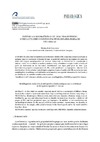Please use this identifier to cite or link to this item:
https://accedacris.ulpgc.es/handle/10553/70443
| DC Field | Value | Language |
|---|---|---|
| dc.contributor.author | Gallucci, María José | en_US |
| dc.date.accessioned | 2020-02-21T10:33:03Z | - |
| dc.date.available | 2020-02-21T10:33:03Z | - |
| dc.date.issued | 2018 | en_US |
| dc.identifier.issn | 2386-8635 | en_US |
| dc.identifier.uri | https://accedacris.ulpgc.es/handle/10553/70443 | - |
| dc.description.abstract | En este estudio consideramos el discurso referido (DR) como una categoría en la que se agrupan como un continuum diferentes formas. A partir del análisis de un conjunto de muestras orales del Corpus sociolingüístico de Caracas 2004-2013 –o PRESEEA-CA– (Bentivoglio y Malaver, 2006, 2012; Gallucci, González y Malaver, 2013) estratificadas según la edad, el sexo y el grado de instrucción de los hablantes, identificamos seis tipos principales de citas –que denominamos propias o propiamente de DR– y dos periféricas –o impropias–. Además de la clasificación y de los criterios metodológicos empleados para el análisis del DR en conversaciones semidirigidas, describimos su distribución en la muestra, con especial referencia a la cita directa, y en relación con las variables sociales antes descritas. | en_US |
| dc.description.abstract | In this study we consider reported speech (RS) as a continuum of different forms. Based on the analysis of spoken discourse from Corpus sociolingüístico de Caracas 2004-2013 –or PRESEEA-CA– (Bentivoglio y Malaver 2006, 2012; Gallucci, González y Malaver, 2013), which is stratified by age, sex, and educational level, we identify six main types of quotes –which we call proper of RS– and two peripheral types –or improper–. In addition to our classification and methodological criteria for the analysis of RS in semi-structured conversations, we describe its distribution on the sample, with special reference to the direct speech and to the social variables described above. | en_US |
| dc.language | spa | en_US |
| dc.relation.ispartof | Philologica canariensia | en_US |
| dc.source | Philologica canariensia [ISSN 2386-8635], n. 24, p. 55-75 | en_US |
| dc.subject | 550510 Filología | en_US |
| dc.subject | 570107 Lengua y literatura | en_US |
| dc.subject.other | Discurso referido | en_US |
| dc.subject.other | Continuum | en_US |
| dc.subject.other | Sociolingüística | en_US |
| dc.subject.other | PRESEEA | en_US |
| dc.subject.other | Español de Caracas | en_US |
| dc.subject.other | Reported speech | en_US |
| dc.subject.other | Continuum | en_US |
| dc.subject.other | Sociolinguistics | en_US |
| dc.subject.other | Spanish spoken in Caracas | en_US |
| dc.title | Estudio sociolingüístico del discurso referido como categoría y continuum en el español hablado de Caracas | en_US |
| dc.type | Article | en_US |
| dc.type | info:eu-repo/semantics/article | en_US |
| dc.identifier.doi | 10.20420/PhilCan.2018.197 | en_US |
| dc.investigacion | Artes y Humanidades | en_US |
| dc.type2 | Artículo | en_US |
| dc.identifier.ulpgc | Sí | es |
| dc.description.esci | ESCI | |
| dc.description.fecytq | Q4 | |
| dc.description.fecytpuntuacion | 21,19 | |
| dc.description.dialnetimpact | 0,0 | |
| dc.description.dialnetq | Q3 | |
| dc.description.dialnetd | D6 | |
| dc.description.erihplus | ERIH PLUS | |
| item.fulltext | Con texto completo | - |
| item.grantfulltext | open | - |
| Appears in Collections: | Artículos | |
WEB OF SCIENCETM
Citations
6
checked on Jun 8, 2025
Page view(s)
50
checked on Nov 4, 2023
Download(s)
72
checked on Nov 4, 2023
Google ScholarTM
Check
Altmetric
Share
Export metadata
Items in accedaCRIS are protected by copyright, with all rights reserved, unless otherwise indicated.
